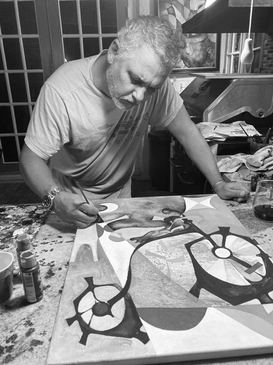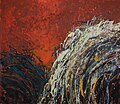Emilio Falero is a Cuban Fine Arts painter residing in Florida.

Humberto Calzada is a Cuban-American artist living in Miami, Florida, since 1960.
Jesus Fuertes was a Cubist painter, who was initiated into the world of art by Salvador Dalí, and was described as a "true genius" by Pablo Picasso. Fuertes often chose women and cats as his subject matter. Several of his well-known works involve the use of shades of blue, which earned him the nickname "Painter of Blue".

Josignacio is a Cuban Contemporary artist and author. He is among the most significant living contemporary Cuban and Latin American artists due to his career auction records, paint medium innovations, and association with notable cultural events, venues, and celebrity figures in the United States and Cuba.
Carlos Alfonzo (1950–1991) was a Cuban-American painter known for his neo-impressionistic style. His work has been collected by Whitney Museum of American Art and Smithsonian Institution.
José María Mijares was a Cuban contemporary visual artist. He began drawing in his adolescent years and entered the San Alejandro Academy of Fine Arts on a scholarship at the age of 16. His greatest influences were the artists of the "Havana School": Carlos Enríquez, René Portocarrero, Cundo Bermúdez, as well as his professors, most notable being modernist painter Fidelio Ponce. He was also a part of the influential group, Los Diez Pintores Concretos, or as they are usually referred to, Los Diez. Although the group had a relatively short life, 1959–1961, and exhibited together only a few times, they remain an important part of Cuba's art history especially in the pre-Castro years and leading up to the revolution. He left Cuba in 1968, resigning his teaching position at the academy when Fidel Castro came into power. Based in Miami, he continued to be a prolific painter and until his death in 2004, at the age of 82.

Rafael Consuegra was a Cuban-born American sculptor and ceramist who worked in the United States and Europe.

Jesús A. Permuy is a Cuban-American architect, urban planner, human rights activist, art collector, and businessman. He is known for an extensive career of community projects and initiatives in Florida, Washington, D.C., and Latin America.
Lourdes Gómez Franca, better known simply as Lourdes, was a Cuban-American painter and poet who was active in Cuba and the United States. Her work was significant in Miami and Cuban art communities of the later Twentieth Century and covered by many critics and scholars.

Juan González was an important twentieth-century Cuban-American painter who rose to international fame in the 1970s and remained active until his death in the 1990s. Born in Cuba, González launched his art career in South Florida during the early 1970s and quickly gained recognition in New York City, where he subsequently relocated in 1972. While in New York González won several fine art awards, including the National Endowment of the Arts, New York Foundation for the Arts grant, and the Cintas Fellowship. González's art known is for its distinctive hyperrealism and magical realism elements delivered in a highly personal style with symbolic overtones. His work has been widely exhibited throughout the United States as well as internationally in Europe, Latin America, and Japan. He is included in the permanent collections of The Metropolitan Museum of Art, Art Institute of Chicago, The Carnegie Museum of Art, and Hirshhorn Museum and Sculpture Garden.
Dionisio Perkins, better known as Dennis Perkins, was a Cuban artist recognized as a key member of the early Cuban exile art community in South Florida.
Marcos F. Pinedo is a Cuban–American art patron, collector, and art dealer who was an active figure in contributing to the establishment of the Cuban and Latin American art market in South Florida. He and his wife, Josefina Camacho Pinedo, own the Pinedo fine art collection of prominent Latin American and European art.
Miguel Jorge (1928–1984), also known as “Micky” Jorge, was a Cuban artist who was influential in the establishment of South Florida's early Latin American art market in the Greater Miami area from the 1960s through the 1980s.
Luis Marín is a Cuban Neo-expressionist painter and visual artist. He has been active internationally in the arts since the 1980s and is featured in the permanent collections of several prominent fine art institutions including the Museum of Latin American Art and Museum of Art Fort Lauderdale.

Adriano Adolfo Fernandez Nicot is a Cuban-American painter and poet based in Miami, Florida. He is known for a distinctive Neo-Expressionist style and is closely associated with the prominent Cuban artists Antonia Eiriz, Manuel Vidal Fernández, and Hilda Vidal Valdés. After becoming established in Cuba, Nicot relocated to the United States in the late 1990s. His work has since been featured in several books and exhibitions in the US and in Latin America.

Marta Cazañas Permuy was a Cuban-American fine art patron, art collector, curator, art dealer, and promoter based in Coral Gables, Florida. She was an influential figure in the establishment of the Latin American art market of South Florida. She managed and co-founded Permuy Gallery, one of the first venues dedicated to Cuban art in the United States. She also hosted a long-running art salon where South Florida art, literary, business, and political figures would gather to discuss art and culture.
Margarita Cano was a Cuban-American artist, curator, scholar, former liaison of the Miami-Dade Public Library System and Center for the Fine Arts, and former Head of Community Relations for the Miami-Dade Public Library System. She was a significant contributor to the development of the Latin American art market of South Florida as a leading figure in the City of Miami and Miami-Dade County public library systems. Cano is responsible for launching the permanent art collection of the Miami-Dade County Library System as well as spearheading several milestone Miami art and literary events of the 1980s, such as Surrounded Islands, The Miami Generation exhibition, and the Miami Book Fair.

Ramón Unzueta was a Cuban-Spanish painter most active in the United States, Spain, and France. In the United States he was a significant figure in the emergence of the Little Havana art market in Miami during the early 21st century. In his lifetime Unzueta received contemporary cultural recognition through public honors, media coverage, and high-profile international collaborations and commissions. Since his death, his work and career have been the subject of analysis through published literature, film, and posthumous exhibitions. Unzueta's work is featured in the permanent collections of the Frost Art Museum and the American Museum of the Cuban Diaspora.

Edel Alvarez Galban, also known artistically as A. Galban, is a Cuban American visual artist and physician. His work has been featured in national and international fine art exhibitions and events as well as in public art, published literature, and televised Latin American media. He has been noted as a significant figure of Contemporary Cuban art in Central Florida by helping to establish its presence above South Florida in the 21st century. Galban's work has been exhibited in the United States, Cuba, Mexico, and Costa Rica.
Pedro Hernandez Dominguez is a Cuban American artist primarily known for his sculptures in wood and stone as well as paper medium works. Since beginning his art career in the 1950s, he has been primarily active in Cuba, the United States, and Europe. He is among the significant contributing artists to the establishment of Cuban art in South Florida during the 20th century. His artwork has gained recognition for his awards, use in public art, coverage in media and published Cuban art literature, as well as international exhibitions. Hernandez is included in the permanent collection of the Museo Nacional de Bellas Artes de La Habana, the Museum of Geometric and MADI Art, the City of Hialeah, and the Miami-Dade Public Library System.












